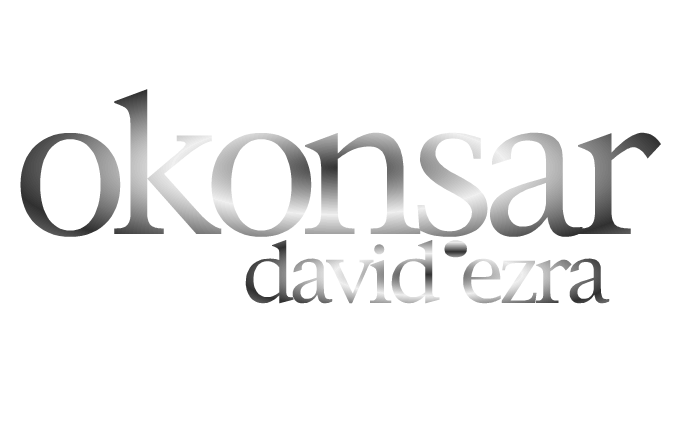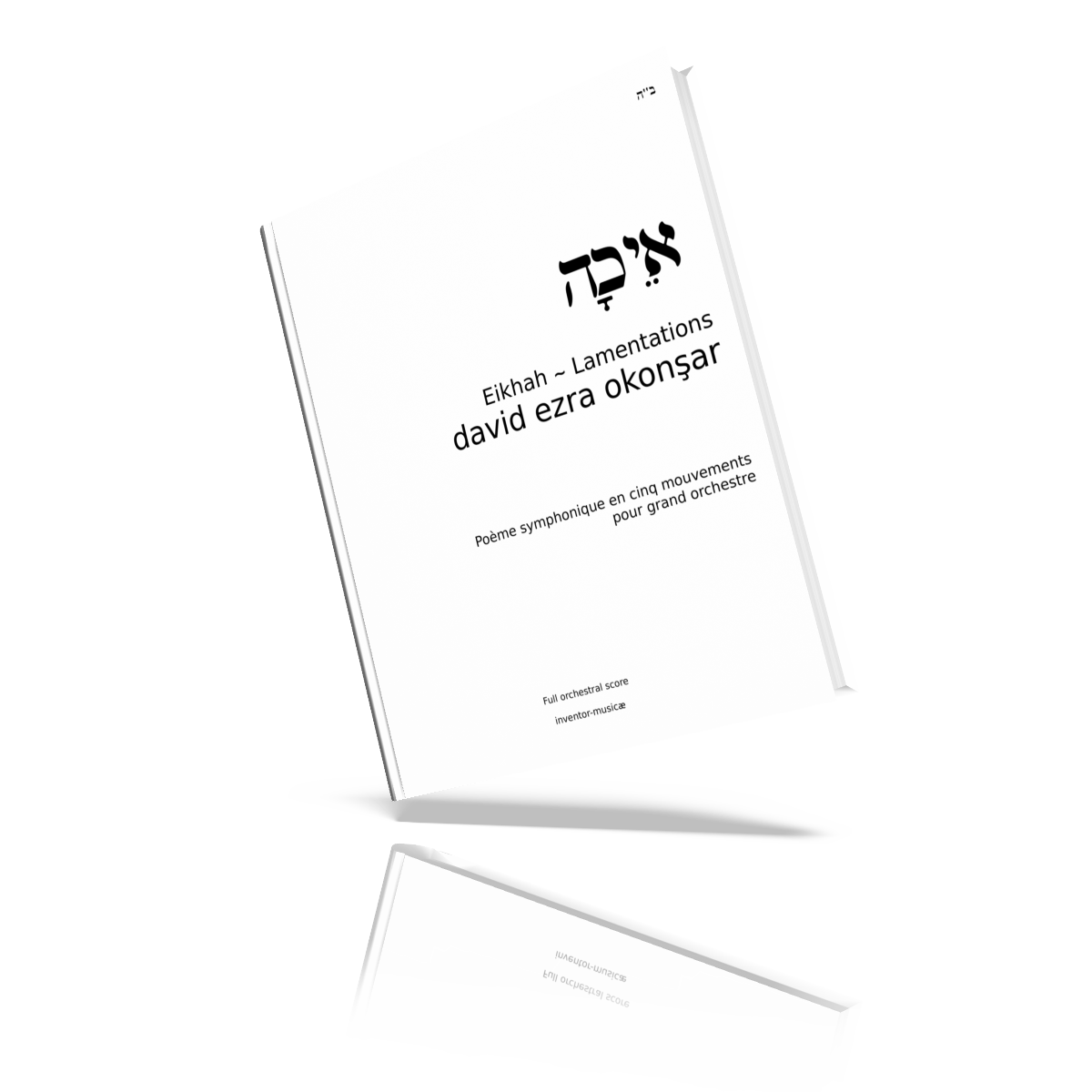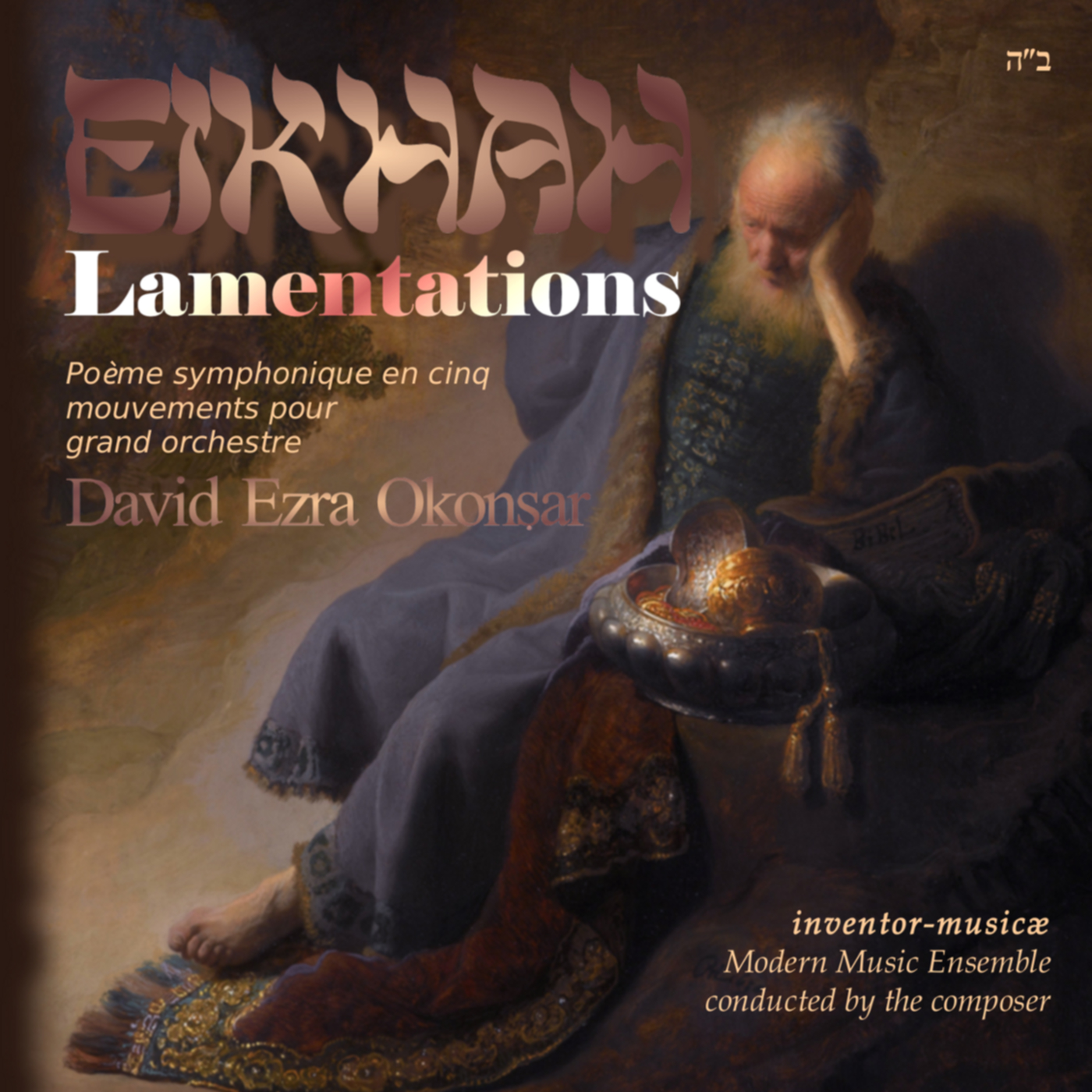
Symphonic Poem in Five Movements for Grand Orchestra


|
The composition is not descriptive, however the general "tone" of the poems which constitute "Eikhah" reflect on every movement. It is not a Symphony in the traditional meaning because it does not fit in the sonata form: two opposing and complementary themes or ideas. Rather it is a Symphonic Poem without "programme", where each movement is inspired from the poems of the book "Lamentations" (Eikhah). The composition employs a large orchestra, with a full set of percussion instruments. One main tone-series is used as a "leitmotiv", this series is used as is in the first and last movements and its variations are employed in others. The pitch material on which all movements are based is in the form of one main and some derivative tone-rows which emphasize the intervals of minor and major thirds. The result of this selection of pitches creates an overall sound-color which stands apart from the usual distinction of consonant versus dissonant. The music can be at times almost "post-Romantic", i.e. Bruckner-like, but also "pointillistic" at others. I. How doth the city sit solitary, that was full of people! - Andante doloroso אֵיכָה יָשְׁבָה בָדָד, הָעִיר רַבָּתִי עָם--הָיְתָה A plaintive "call" from the Oboe starts the first movement. Strings create a complex polyphony as a kind of "magma" expanding from the Oboe tone. The main tone row, used here as a theme or "leitmotiv", emerges occasionally. Few bright sections as "light rays" occur with staccato octaves on Flutes, Celesta and Harp. A powerful crescendo of the brass section unveils the view of devastated Jerusalem, which emerges as a nightmare like vision. The English Horn solo over ostinato chords on the Violas and Cellos, punctuated with Double bass pizzicatos is the inner talking of the Prophet. In sheer horror, the reality surpasses even what can be witnessed or imagined by the Prophet. The big crescendo leading to the last section brings out two simultaneous solos on Violin and Violoncello. The Violin solo is desperately climbing to extreme high ranges it is mercilessly punctuated with tutti Cello short and strong chords. The movement ends as it started with plaintive held notes at the woodwinds. II. How hath the Lord covered with a cloud the daughter of Zion in His anger! Prestissimo ֵאֵיכָה יָעִיב בְּאַפּוֹ אֲדֹנָי, אֶת-בַּת-צִיּוֹן--הִשְׁלִיךְ מִשָּׁמַיִם אֶרֶץ A "quasi chromatic" run at the fastest possible tempo on the double-basses is punctuated with down-bow violoncello attacks. This sets the landscape for this bloodcurdling movement. Held chords at bassoons and violins, mostly made of minor second intervals complete the background. After that tumultuous start, derivatives of the double-bass running figures are also used, mostly at the first Clarinet part, to create some melody-like figures over a background on harps, Celesta, mallets, this time "piano" and in the high ranges. Even though the time signature and tempo changes frequently, the perceived ebullience remains constant even at light dynamics. The runs seen at the beginning start again at the end of the movement, but this time they are cut into short sections and distributed among various instruments. The movement ends without a clearly perceptible "Coda", as if it is still going on even after the end. III. I am the man that hath seen affliction by the rod of His wrath. Non troppo lento אֲנִי הַגֶּבֶר רָאָה עֳנִי, בְּשֵׁבֶט עֶבְרָתוֹ. This movement is an introspection. It starts with a relatively consonant polyphony which turns either to blasting brass instrument chords projecting the horror which surrounds the Prophet in the real world, or into a chromatic step "leitmotiv" which symbolizes the inner and personal feelings of the witness of the horror. A developing oboe melody on a soft strings background may remind a similar passage of the first movement. But this time the melody has no possibility to expand, it is being interrupted by bursts of tutti sections. IV. How is the gold become dim! Molto lento אֵיכָה יוּעַם זָהָב The movement is based on the contrast between gold, shine, radiance which are symbolically related with Jerusalem and darkness, obscurity referring to the invaders and the ruination of the city. Bright scenes, orchestrated with the use of Celesta, Glockenspiel, harps and high woodwinds are interwoven with the dark reality on low brass and low strings. The unveiling of those various contrasting scenes can be either subtle or sudden, the "past" glory of Jerusalem symbolized as "gold" by the author-prophet may even be superposed over the dark and terrifying reality. V. Remember, O LORD, what is come upon us. Moderato זְכֹר יְהוָה מֶה-הָיָה לָנוּ This is again a prayer, but not a peaceful and serene one as the events witnessed are so overwhelming. The music reflects various remembrances from the preceding movements. Several discontinued melodic or rhythmic elements intervene to de-stabilize whenever the music tries to get into a calm and straight discourse.
|
|||||||||
|
|||||||||
| Click to look at the score (preview of some 70 pages out of 247) ... |
|||||||||
|







